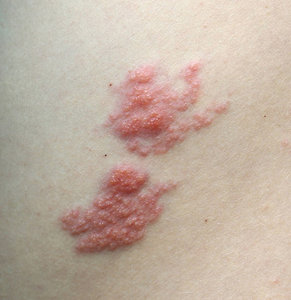Editor's Note: The following was written by Dr. Lee Chen-Yu and translated / edited by Scott Herbster.
Herpes zoster (shingles) directly corresponds with the pathologic terms "girdling fire cinnabar" and "girdling snake cinnabar," as described in Chinese medicine external medicine texts.
The therapeutic regimen includes medicinal formulas (e.g., Long Dan Xie Gan Tang), bleeding locally and distally, topical application of a medicinal powder, and acupuncture (e.g., Tai Chong (LV 3) and Zhong Feng (LV 4)).
Chinese medicine treatment of herpes zoster expedites the resolution of acute symptoms (e.g., pain, paresthesia, erythematous maculopapular rash, vesicular lesions, itching) and prevents the potential for complications. It can also provide effective treatment for the rarer subtypes that may affect the eyes (herpes zoster ophthalmicus), ears (herpes zoster oticus) and face (facial nerve palsy); as well as complications such as posthepatic neuralgia (phantom pain), bacteremia, sepsis, meningitis, and encephalitis.
Etiology, Pathophysiology, Pathomechanism, & Disease Patterns
 Western medicine explains the etiology and pathophysiology of herpes zoster as reactivation of the varicella-zoster virus (VZV). The initial infection with VZV usually occurs early in life and presents as chickenpox (varicella), after which the virus remains dormant in dorsal root or cranial nerve ganglion(s).
Western medicine explains the etiology and pathophysiology of herpes zoster as reactivation of the varicella-zoster virus (VZV). The initial infection with VZV usually occurs early in life and presents as chickenpox (varicella), after which the virus remains dormant in dorsal root or cranial nerve ganglion(s).
Once the immune system becomes compromised (e.g., stress, fatigue, old age), the individual is susceptible to reactivation along the dermatome innervated by the respective nerves affected.1
In Chinese medicine, the pathomechanism of herpes zoster can be identified as residual exterior wind-heat evil that has not been completely eradicated; and residual heat toxin accumulation pattern.2
Internal, external or neutral causes, including external contraction, disharmony of the seven affects, sexual intemperance, or lifestyle irregularities, may "awaken" (reactivate) the residual evil-toxin that had originally laid dormant. Once the evil-toxin has been "awakened," this can be identified as heat exuberance and damp depression in the liver channel, and fire heat and accumulated heat toxin pattern.
Key Clinical Features
Herpes zoster most commonly affects the dermatome(s) of the thoracic and lumbar region, and manifests unilaterally.1 At the onset, common cold symptoms (e.g., fever, chills, headache, fatigue) will typically present. A few days later, painful sensations (tingling, burning or throbbing) commonly present along the affected dermatome(s); and then an itchy erythematous maculopapular rash that quickly evolves into vesicular lesions will appear.
The pain is often described as feeling like boiling water or burning fire that throbs with every heartbeat, or like a chicken pecking, or a needle stabbing the body. A few days later, the vesicles will typically break open, crust over and degrade; however, in some cases in which the patient has not been treated effectively, the lesions may become necrotic.
Though much less common, some patients may present with subtypes that affect the ophthalmic division of the trigeminal nerve (herpes zoster ophthalmicus), geniculate ganglion affecting the facial and vestibulocochlear cranial nerves (herpes zoster oticus), and facial nerve (facial nerve palsy).1 Herpes zoster ophthalmicus and herpes zoster oticus tend to involve a more complicated clinical presentation and almost always result in the manifestation of phantom pain (postherpetic neuralgia).
Chinese Medicine Treatment
The therapeutic regimen for the treatment of herpes zoster at the early onset and during the acute stage includes the prescription of an orally administered medicinal formula, bleeding locally at the site of the lesion and distally at the well points of corresponding channels, topical application of a medicinal powder, and performing acupuncture on the acupoints of corresponding channels.
For medicinal treatment, prescribe an orally administered, heat-abating with cold and bitterness and liver fire-draining, damp-heat-clearing formula variant, such as Long Dan Xie Gan Tang or Huang Lian Jie Du Tang, adding Long Dan Cao. This formula functions as an antiviral to treat the root of the pathocondition.
Use a lancet to bleed locally around the peripheral border of the erythematous maculopapular rash and puncture any vesicles (fluid-filled blisters) or pustules (pus-filled blisters), so the fluid or pus exudes. Topically apply Xiong Huang (powder) on the erythematous maculopapular rash (including the peripheral border) and vesicles or pustules. Then, cover the site with gauze to keep dry and clean.
Also, bleed distally at the well points on the liver, spleen and stomach channels. If lesions present on the back, bleed Wei Zhong (UB 40); and for generalized symptoms (e.g., fever, chills, headache, malaise), also bleed above, on and below Da Zhui (GV 14).
Herpes Zoster: Bleeding and Xiong Huang (Powder) Topical Application Procedure |
|
Perform acupuncture on the essential acupoints Tai Chong (LV 3) and Zhong Feng (LV 4), as well as distal acupoints on channels that correspond with the affected sites. For instance, if lesions present on the chest, needle Nei Guan (PC 6), Chi Ze (LU 5), Chong Yang (ST 42), and Jiao Xi (ST 41); on the back, needle Wei Zhong (UB 40), Wai Guan (SJ 5) and Hou Xi (SI 3); and on the rib side, needle Wai Guan (SJ 5) and Yang Ling Quan (GB 34). If there are generalized symptoms, also needle Feng Chi (GB 20) and Tian Zhu (UB 10).
Editor's Note: References supporting the in-text citations accompany part 2 of this article, scheduled for the January 2023 issue. Part 2 discusses several potential complications of herpes zoster and appropriate management with Chinese medicine.
Dr. Lee Chen-Yu has served as the director of Yu Sheng Chinese Medicine Clinic in Taiwan for over 40 years. He has been actively engaged in the clinical application, instruction,and research of Chinese medicine — a visionary rooted in the classics and attuned to our modern environment. Learn more at www.facebook.com/groups/2982083568778240.
Scott Herbster graduated with a bachelor's degree in Chinese medicine from China Medical University in Taiwan. He has worked as a clinical practitioner for more than 20 years and authored the three-volume book series Integrative Chinese Herbal Therapy (available on Amazon.com).



